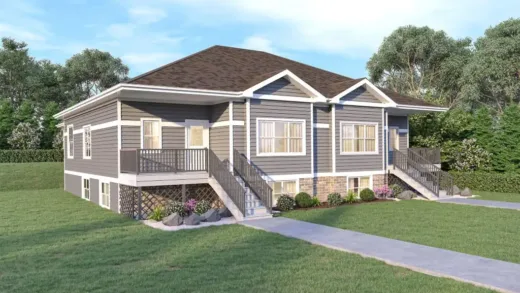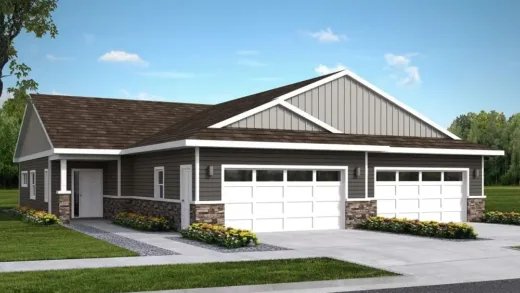The history of condo development in Dane County, Wisconsin, is a fascinating narrative of urban planning, economic trends, and evolving lifestyle preferences. From the early days of modest, practical buildings to the current landscape of luxurious, amenity-rich complexes, the condo market in Dane County has undergone significant transformation.
This article explores the key developments, milestones, and trends that have shaped the condominium market in this dynamic region.
Contents
Early Beginnings: 1960’s – 1970’s
The concept of condominiums gained traction in the United States in the 1960’s, following the passage of the Housing Act of 1961, which provided federal backing for the development of multi-family housing units. Dane County, home to the state capital Madison and the University of Wisconsin, began to see its first condominium projects during this period.
The initial wave of condominiums in Dane County was modest in scale. These early developments were primarily aimed at providing affordable housing options for middle-class families and young professionals. They offered an alternative to traditional single-family homes, especially in urban areas where space was limited. Key developments from this era included small complexes with basic amenities, located in close proximity to downtown Madison and the university.
Growth and Expansion: 1980’s – 1990’s
The 1980’s and 1990’s marked a period of significant growth and expansion for the condominium market in Dane County. During this time, the region experienced robust economic growth, driven by the technology sector, healthcare, and the university. This economic boom led to increased demand for diverse housing options, including condominiums.
Developers began to recognize the potential of condominiums as a profitable venture, leading to the construction of larger and more varied projects. The 1980’s saw the introduction of more upscale developments, offering enhanced amenities such as swimming pools, fitness centers, and security services. These new complexes were often situated in desirable locations, including waterfront properties along Lake Mendota and Lake Monona.
Consolidation and Diversification: 2000’s
The turn of the millennium brought further consolidation and diversification to the Dane County condominium market. As the county continued to grow, with Madison consistently ranking among the best places to live in the United States, the demand for condos remained strong. Developers responded by diversifying the types of condominium units available, catering to a broader range of buyers.
The 2000’s saw the rise of mixed-use developments, combining residential, commercial, and retail spaces. These projects aimed to create vibrant, self-contained communities where residents could live, work, and play without needing to travel long distances.
One notable development from this era is the Marina Condominiums, completed in 2005. Located on the shores of Lake Mendota, this project featured luxury units with lake views, private docks, and other high-end amenities, setting a new standard for condominium living in the region.
Another prominent example is the Capitol West project, a mixed-use development in downtown Madison that includes luxury condos, office spaces, and retail stores. Completed in 2008, Capitol West reflects the growing trend towards urban living and the desire for convenience and accessibility.
During this decade, there was also a surge in eco-friendly and sustainable building practices. The condominium market in Dane County began to see developments that prioritized green construction techniques, energy efficiency, and sustainable materials. The Monroe Commons project, completed in 2006, is a prime example. Located in the vibrant Monroe Street neighborhood, this development features environmentally friendly design elements and has become a model for sustainable urban living.
The Impact of the Housing Crisis: Late 2000’s
The late 2000’s were marked by the global financial crisis, which had a profound impact on the real estate market nationwide, including in Dane County. The condominium market experienced a slowdown as financing became more difficult to obtain, and consumer confidence waned. Many planned projects were put on hold or canceled, and the pace of new developments slowed significantly.
Despite these challenges, Dane County’s condominium market proved relatively resilient compared to other regions. The strong local economy, bolstered by the presence of the university and a diverse job market, helped mitigate some of the adverse effects. While there was a temporary dip in demand, the market began to recover by the early 2010’s.
Recovery and Modernization: 2010’s
The recovery of the condominium market in Dane County during the 2010’s was marked by modernization and a renewed focus on urban living. As the economy rebounded, developers once again saw opportunities in the condo market, leading to a new wave of construction projects.
A key trend during this period was the emphasis on modern, high-tech amenities. New developments incorporated features such as smart home technology, high-speed internet, and advanced security systems. The Constellation, a high-rise condominium completed in 2013 in Madison’s Capitol East District, exemplifies this trend. With its sleek design, modern amenities, and prime location near entertainment and dining options, The Constellation has become a sought-after residence for young professionals and retirees alike.
The 2010’s also saw a focus on creating more affordable condominium options to address the housing needs of a broader segment of the population. Initiatives to promote affordable housing, including partnerships between developers and local government, led to the creation of projects like the Union Corners development. This mixed-use project includes a significant number of affordable housing units, ensuring that the benefits of urban living are accessible to a wider range of residents.
Recent Trends and Future Outlook: 2020’s
Entering the 2020’s, the condominium market in Dane County continues to evolve, driven by changing demographics, economic factors, and lifestyle preferences. One of the most significant trends in recent years has been the impact of the COVID-19 pandemic, which has reshaped the way people think about housing and urban living.
The pandemic accelerated the demand for flexible living spaces, leading to increased interest in condominiums that offer home office amenities, outdoor spaces, and access to recreational facilities. Developers have responded by designing units that cater to remote work and incorporating more communal areas that allow for social distancing.
Another notable trend is the growing interest in suburban and exurban developments. While downtown Madison remains a prime location for condominium projects, there is also significant growth in suburban areas such as Middleton, Fitchburg, Sun Prairie and Stoughton. These areas offer a blend of urban convenience and suburban tranquility, attracting families and individuals seeking a balance between city life and open spaces.
Sustainability remains a key focus, with many new developments striving for LEED certification and other green building standards. Projects like the Garver Feed Mill redevelopment, which includes eco-friendly condos and community spaces, highlight the ongoing commitment to environmental sustainability in the region.
Looking ahead, the condominium market in Dane County is poised for continued growth and diversification. As the region’s population increases and urban areas expand, the demand for varied housing options will persist. The emphasis on mixed-use developments, affordability, and sustainability will likely shape the future landscape of condominium living in Dane County.
Key Developments and Milestones
- Marina Condominiums (2005): One of the first luxury condominium projects in Dane County, setting a new standard for high-end living with waterfront views and premium amenities.
- Monroe Commons (2006): A pioneering sustainable development, incorporating eco-friendly design and construction practices, becoming a model for green living.
- Capitol West (2008): A landmark mixed-use development in downtown Madison, combining residential, commercial, and retail spaces, exemplifying the trend towards urban, self-contained communities.
- Union Corners (2010’s): A mixed-use project with a significant affordable housing component, addressing the need for accessible urban living options.
- The Constellation (2013): A modern high-rise with state-of-the-art amenities, catering to the growing demand for high-tech, urban living spaces.
Conclusion
The history of condominium development in Dane County, Wisconsin, is a testament to the region’s dynamic growth and adaptability. From modest beginnings in the 1960’s to the current era of modern, diverse, and sustainable living spaces, the Dane County condominium market has continually evolved to meet the changing needs and preferences of its residents. As Dane County continues to grow and innovate, the future of condominium development looks promising, with a focus on inclusivity, sustainability, and urban vitality.









